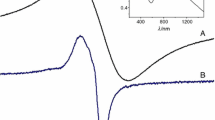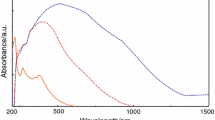Abstract
New species of type MLCl2·nH2O (M:Ni, n = 4.5; M:Cu, n = 0 and M:Zn, n = 0; L: (4,5-11,12)-bisphenylen-1,3,6,8,10,13-hexaazacyclotetradecan-bis(pyrid-3-yl)methanone resulted by 1,2-phenylendiamine, nicotinamide and formaldehyde template condensation) were synthesised. The complex features have been assigned from microanalytical, IR, UV–Vis, 1H NMR and EPR spectra as well as magnetic data at room temperature. Simultaneous TG/DTA and TG/DSC/EGA measurements were performed in order to evidence the thermal decomposition pattern and the nature of the gaseous products formed in each step. Processes as water and chloride elimination as well as fragmentation and oxidative degradation of the organic ligand were observed during the thermal decomposition. The final product of decomposition was metal(II) oxide. The obtained complexes exhibited an improved antimicrobial activity in comparison with the ligand, both on planktonic and biofilm embedded cells, as well as a low cytotoxicity. The microbicidal and anti-biofilm activity of the complex (3) against the Gram-negative strains recommend it for the development of new antimicrobial solutions for these emerging multidrug-resistant bacteria causing life-threatening infectious diseases often untreatable with the existing antimicrobial agents. The assay on HEp-2 cells indicates a low cytotoxicity for all complexes. The plethysmometry assays indicate an anti-inflammatory activity for Cu(II) complex.




Similar content being viewed by others
References
Mewis RE, Archibald SJ. Biomedical applications of macrocyclic ligand complexes. Coord Chem Rev. 2010;254:1686–712.
Srour H, Le Maux P, Chevance S, Simonneaux G. Metal-catalyzed asymmetric sulfoxidation, epoxidation and hydroxylation by hydrogen peroxide. Coord Chem Rev. 2013;257:3030–50.
Costamagna J, Ferraudi G, Matsuhiro B, Campos-Vallette M, Canales J, Villagran M, Vargas J, Aguirre MJ. Complexes of macrocycles with pendant arms as models for biological molecules. Coord Chem Rev. 2000;196:125–64.
Gerbeleu NV, Arion VB, Burgess John P. Template synthesis of macrocyclic compounds. Weinheim: Wiley; 1994.
Wainwright KP. Synthetic and structural aspects of the chemistry of saturated polyaza macrocyclic ligands bearing pendant coordinating groups attached to nitrogen. Coord Chem Rev. 1997;166:35–90.
Lindoy LF. The transition metal ion chemistry of linked macrocyclic ligands. Adv Inorg Chem. 1998;45:75–125.
McKee V. Macrocyclic complexes as models for nonporphine metalloproteins. Adv Inorg Chem. 1993;40:323–410.
Parkin G. Synthetic analogues relevant to the structure and function of zinc enzymes. Chem Rev. 2004;104:699–767.
Albedyhl S, Averbuch-Pouchot MT, Belle C, Krebs B, Pierre JL, Saint-Aman E, Torelli S. Dinuclear Zinc(II)–Iron(III) and Iron(II)–Iron(III) complexes as models for purple acid phosphatases. Eur J Inorg Chem. 2001;6:1457–64.
Tiné MR. Cobalt complexes in aqueous solutions as dioxygen carriers. Coord Chem Rev. 2012;256:316–27.
de Alwis C, Crayston JA, Cromie T, Eisenblätter T, Hay RW, Lampeka YD, Tsymbal LV. Cyclic voltammetry study of the electrocatalysis of carbon dioxide reduction by bis(polyazamacrocyclic) nickel complexes. Electrochim Acta. 2000;45:2061–74.
Salavati-Niasari M, Davar F. Synthesis, characterization and catalytic activity of copper(II) complexes of 14-membered macrocyclic ligand; 3,10-dialkyl-dibenzo-1,3,5,8,10,12-hexaazacyclotetradecanel/zeolite encapsulated nanocomposite materials. Inorg Chem Commun. 2006;9:304–9.
Mochizuki K, Suzuki M. Photochemical dehalogenation mediated by macrocyclic nickel(II) complexes. Inorg Chem Commun. 2011;14:902–5.
Salavati-Niasari M. 16-Membered pentaaza bis(macrocyclic) nickel(II) complexes containing aromatic nitrogen–nitrogen linkers, [Ni([16]aneN5)]2R}(ClO4)4: synthesis, characterization and catalytic oxidation of cyclohexene with molecular oxygen. J Mol Catal A Chem. 2007;272:207–12.
Salavati-Niasari M, Bazarganipour M. Bis(macrocyclic) copper(II) complexes containing aromatic nitrogen–nitrogen linkers produced by in situ one pot template condensation reaction (IOPTCR): synthesis, characterization and catalytic oxidation of tetrahydrofuran. Inorg Chem Commun. 2006;9:332–6.
Caravan P, Ellison JJ, McMurry TJ, Lauffer RB. Gadolinium(III) chelates as MRI contrast agents: structure, dynamics, and applications. Chem Rev. 1999;99:2293–352.
Dearling JLJ, Voss SD, Dunning P, Snay E, Fahey F, Smith SV, Huston JS, Meares CF, Treves ST, Packard AB. Imaging cancer using PET—the effect of the bifunctional chelator on the biodistribution of a 64Cu-labeled antibody. Nucl Med Biol. 2011;38:29–38.
Thunus L, Lejeune R. Overview of transition metal and lanthanide complexes as diagnostic tools. Coord Chem Rev. 1999;184:125–55.
Volkert WA, Hoffmann TJ. Therapeutic radiopharmaceuticals. Chem Rev. 1999;99:2269–92.
Nirmala CG, Rahiman AK, Sreedaran S, Jegadeesh R, Raaman N, Narayanan V. Synthesis, characterization, crystal structure and antimicrobial activities of new trans N, N-substituted macrocyclic dioxocyclam and their copper(II) and nickel(II) complexes. Polyhedron. 2011;30:106–13.
Mathur S, Tabassum S. Synthesis and characterization of a new macrocyclic copper(II) complex with an N-Glycosidic pendant arm: in vitro cytotoxicity and binding studies with calfthymus DNA. Chem Biodivers. 2006;3:312–25.
Ronconi L, Sadler PJ. Using coordination chemistry to design new medicines. Coord Chem Rev. 2007;251:1633–48.
Arjmand F, Aziz M, Chauhan M. Synthesis, spectroscopic studies of new water-soluble Co(II) and Cu(II) macrocyclic complexes of 4,15-bis(2-hydroxyethyl)-2,4,6,13,15,17-hexaazatricyclodocosane: their interaction studies with calf thymus DNA and guanosine 50 monophosphate. J Incl Phenom Macrocycl Chem. 2008;61:265–78.
Salavati-Niasari M, Najafian H. One-pot template synthesis and properties of Ni(II) complexes of 16-membered hexaaza macrocycles. Polyhedron. 2003;22:2633–8.
Núńez C, Bastida R, Macías A, Aldrey A, Valencia L. Synthesis of metal complexes with a novel ethyldioxolane pendant-arm hexaazamacrocyclic ligand. Polyhedron. 2010;29:126–33.
Organo VG, Filatov AS, Quartararo JS, Friedman ZM, Rybak-Akimova EV. Nickel(II) complexes of monofunctionalized pyridine-azamacrocycles: synthesis, structures, pendant arm “on-off” coordination equilibria, and peroxidase-like activity. Inorg Chem. 2009;48:8456–68.
Lee Y-T, Kang S-G. One-pot reaction involving two different amines and formaldehyde leading to the formation of poly(macrocyclic) Cu(II) complexes. Bull Korean Chem Soc. 2012;33:2517–22.
Busto E, González-Álvarez A, Gotor-Fernández V, Alfonso I, Gotor V. Optically active macrocyclic hexaazapyridinophanes decorated at the periphery: synthesis and applications in the NMR enantiodiscrimination of carboxylic acids. Tetrahedron. 2010;66:6070–7.
Salavati-Niasari M, Davar F. Synthesis and characterization of nickel(II) complexes of 14-membered hexaaza macrocyclic ligands "3,10-dialkyl-dibenzo-1,3,5,8,10,12-hexaazacyclotetradecane” produced by the in situ one-pot template reaction of formaldehyde and 1,2-phenylenediamine with alkyl or benzyl amine in the presence of the nickel(II) ion. Polyhedron. 2006;25:2127–34.
Licchelli M, Milani M, Pizzo S, Poggi A, Sacchi D, Boiocchi M. Synthesis of novel diazacyclam copper(II) complexes by template reaction involving sulphonamides as locking fragments. Inorg Chim Acta. 2012;384:210–8.
Paik Suh M. Macrocyclic chemistry of nickel. Adv Inorg Chem. 1996;44:93–146.
Shin JW, Yeo SM, Min KS. Copper(II) coordination compounds containing chiral functional groups as pendants: syntheses, crystal structures, and physical properties. Inorg Chem Commun. 2012;22:162–6.
Shakir M, Islam KS, Mohamed AK, Shagufta M, Hasan SS. Macrocyclic complexes of transition metals with divalent polyaza units. Trans Metal Chem. 1999;24:577–80.
Stasiuk GJ, Faulkner S, Long NJ. Novel imaging chelates for drug discovery. Curr Opin Pharmacol. 2012;12:576–82.
Jiang P, Guo Z. Fluorescent detection of zinc in biological systems: recent development on the design of chemosensors and biosensors. Coord Chem Rev. 2004;248:205–29.
Olar R, Badea M, Marinescu D, Chifiriuc M-C, Bleotu C, Grecu MN, Iorgulescu E-E, Lazar V. N, N-dimethylbiguanide complexes displaying low cytotoxicity as potential large spectrum antimicrobial agents. Eur J Med Chem. 2010;45:3027–34.
Pătraşcu F, Badea M, Grecu MN, Stanică N, Măruţescu L, Marinescu D, Spînu C, Tigae C, Olar R. Thermal, spectral, magnetic and antimicrobial behaviour of new Ni(II), Cu(II) and Zn(II) complexes with a hexaazamacrocyclic ligand. J Therm Anal Calorim. 2013;113:1421–9.
Cory AH, Owen TC, Barltrop JA, Cory JG. Use of an aqueous soluble tetrazolium/formazan assay for cell growth assays in culture. Cancer Commun. 1991;3:207–12.
Darzynkiewicz Z. Nucleic acid analysis. In: Robinson JP, managing editor. Current protocols in cytometry. New York: Wiley; 1997. Chap. 7.
Geary WJ. The use of conductivity measurements in organic solvents for the characterisation of coordination compounds. Coord Chem Rev. 1971;7:81–122.
Dziewułska-Kulaczkowska A, Mazur L, Ferenc W. Thermal, spectroscopic and structural studies of Zn(II) complex with nicotinamide. J Therm Anal Calorim. 2009;96:255–60.
Nakamoto K. Infrared and Raman spectra of inorganic and coordination compounds. New York: Wiley; 1986.
Chandra S, Ruchia, Qanungob K, Sharmab SK. New hexadentate macrocyclic ligand and their copper(II) and nickel(II) complexes: spectral, magnetic, electrochemical, thermal, molecular odeling and antimicrobial studies. Spectrochim Acta A Mol Biomol Spectrosc. 2012;94:312–7.
Lever ABP. Inorganic electronic spectroscopy. Amsterdam: Elsevier; 1986.
Hathaway BJ, Billing DE. The electronic properties and stereochemistry of mono-nuclear complexes of the copper(II) ion. Coord Chem Rev. 1970;5:143–207.
Tatucu M, Rotaru P, Rau I, Spinu C, Kriza A. Thermal behaviour and spectroscopic investigation of some methyl 2-pyridyl ketone complexes. J Therm Anal Calorim. 2010;100:1107–14.
Findoráková L, Győryová K, Hudecová D, Mudroňová D, Kovářová J, Homzová K, Nour El-Dien FA. Thermal decomposition study and biological characterization of zinc(II) 2-chlorobenzoate complexes with bioactive ligands. J Therm Anal Calorim. 2013;111:1771–81.
O’Fallon E, Gautam S, D’Agata EMC. Colonization with multidrug-resistant gram-negative bacteria: prolonged duration and frequent cocolonization. Clin Infect Dis. 2009;48:1375–81.
Kriengkauykiat J, Ito JI, Dadwal SS. Epidemiology and treatment approaches in management of invasive fungal infections. Clin Epidemiol. 2011;3:175–91.
Lazar V. Microbial adherence. Bucharest: Romanian Academy Publ. House; 2003.
Letelier ME, Lepe AM, Faúndez M, Salazar J, Marín R, Aracena P, Speisky H. Possible mechanisms underlying copper-induced damage in biological membranes leading to cellular toxicity. Chem Biol Interact. 2005;151:71–82.
Dillon CT, Hambley TW, Kennedy BJ, Lay PA, Weder JE, Zhou Q. Copper and zinc complexes as antiinflammatory drugs. In: Sigel A, Sigel H, editors. Metal ions in biological systems metal ions and their complexes in medication. New York: Marcel Dekker; 2004. p. 253–73.
Acknowledgements
The PhD. student F. Pătraşcu thanks to the Sectorial Operational Programme Human Resources Development (SOP HRD), financed from the European Social Fund and by the Romanian Government under the contract number SOP HRD/107/1.5/S/82514. Support of the EU (ERDF) and Romanian Government, that allowed the acquisition of the research infrastructure under POS-CCE O 2.2.1 project INFRANANOCHEM—No. 19/01.03.2009, is gratefully acknowledged.
Author information
Authors and Affiliations
Corresponding author
Rights and permissions
About this article
Cite this article
Badea, M., Pătraşcu, F., Cerc Korošec, R. et al. Thermal, spectral, magnetic and biologic characterization of new Ni(II), Cu(II) and Zn(II) complexes with a hexaazamacrocyclic ligand bearing ketopyridine moieties. J Therm Anal Calorim 118, 1183–1193 (2014). https://doi.org/10.1007/s10973-014-3857-5
Received:
Accepted:
Published:
Issue Date:
DOI: https://doi.org/10.1007/s10973-014-3857-5




